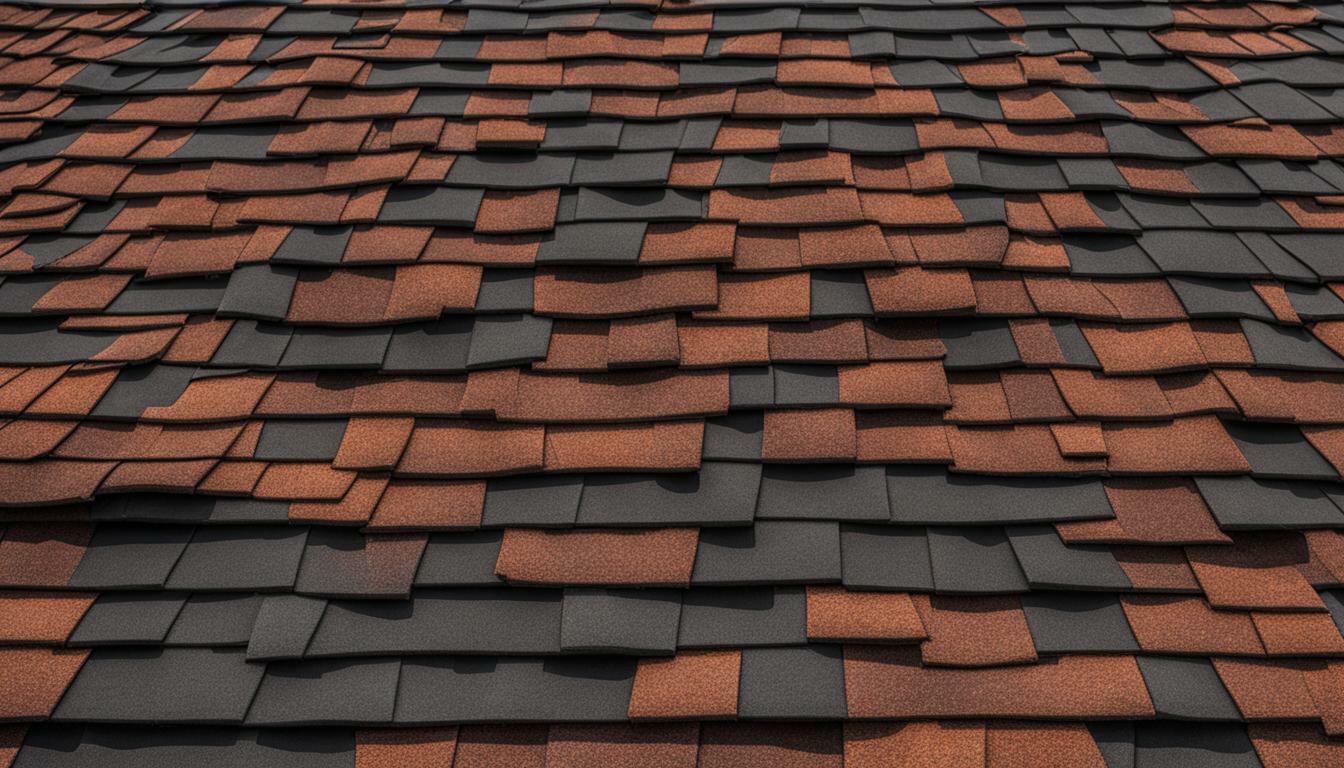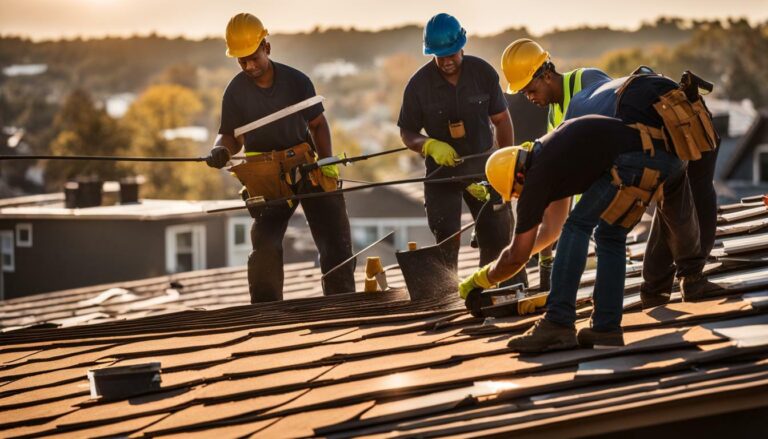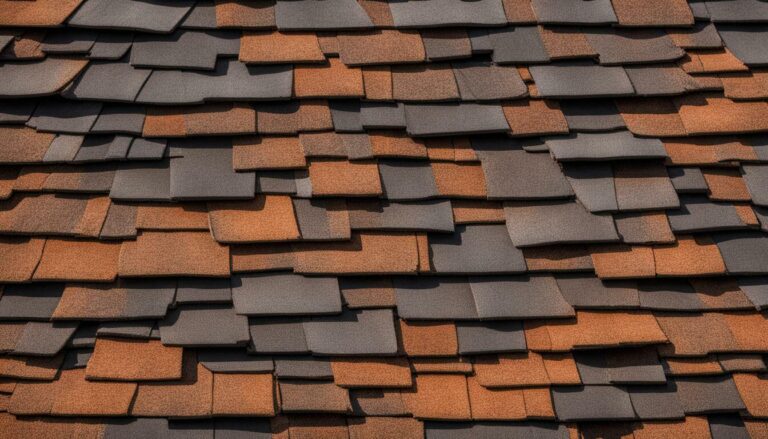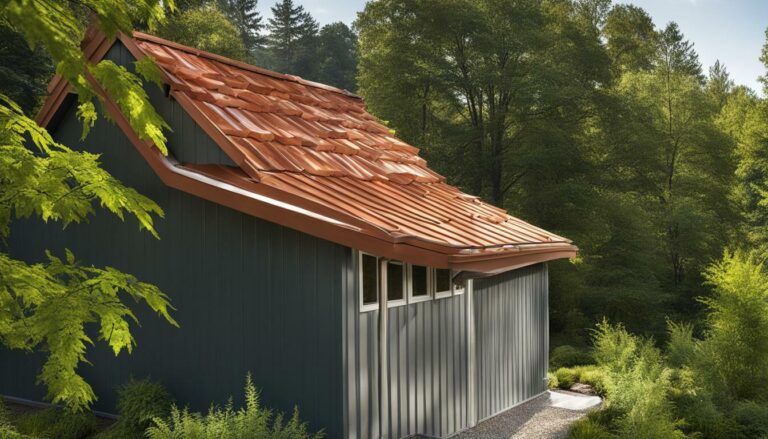Protect Your Home: Preventing Roof Damage from Storms
Storms can cause significant damage to your roof, leading to costly repairs if not addressed promptly. Protecting your home from roof damage caused by storms is crucial to ensure the safety and longevity of your property. By taking preventative measures and implementing regular maintenance, you can safeguard your roof against the destructive forces of nature.
One of the first steps in preventing roof damage from storms is selecting durable roofing materials that are resistant to severe weather conditions. Investing in high-quality materials can provide added protection and reduce the risk of damage. Regular roof inspections, conducted by a professional roofing contractor, can help identify any vulnerabilities and address them before they escalate into more significant issues.
Maintaining your roof also plays a vital role in preventing storm damage. Repairing missing shingles and ensuring proper gutter maintenance can help prevent leaks and water damage. Addressing roof ponding, which is the accumulation of water on the roof’s surface, is crucial to prevent structural damage. Additionally, taking steps to protect your roof from wind damage and sun exposure can strengthen its resilience against storms.
Snow and ice can be particularly damaging to roofs during winter storms. Using roof rakes to remove excess snow, ensuring proper ventilation and insulation, and inspecting for pests can help mitigate potential damage. Preparing your home before a storm by cutting down trees near your property, cleaning gutters, and securing outdoor objects can minimize the risk of roof damage caused by high winds and flying debris.
Regular roof inspections and repairs, along with removing outside debris and parking cars in the garage during storms, are essential to maintain the integrity of your roof. By following these precautions and promptly addressing any damage, you can protect your home from costly repairs and ensure the longevity of your roof.
Key Takeaways:
- Choose durable roofing materials to withstand severe weather.
- Regularly inspect and maintain your roof to address vulnerabilities.
- Repair missing shingles and maintain gutters to prevent water damage.
- Address roof ponding, wind damage, and sun exposure to strengthen your roof’s resilience.
- Protect your roof from snow and ice damage through proper maintenance and inspections.
Signs of Roof Damage from Storms
After a storm, it’s important to inspect your roof for any visible signs of damage. This will help you assess the extent of the impact and take appropriate action to prevent further problems. Here are some key signs to look out for when assessing roof damage caused by storms:
- Missing or damaged shingles: Strong winds can lift and dislodge shingles, leaving your roof vulnerable to leaks and water damage.
- Cracked or curled shingles: Excessive wind and hail can cause shingles to crack or curl, which compromises their ability to protect your home.
- Leaks or water stains: Water stains on your ceiling or walls, as well as signs of moisture in your attic, indicate potential roof damage.
- Granule loss: Check your gutters and downspouts for an excessive amount of granules, as this could signify deteriorating shingles.
- Dented or dinged vents and flashing: Hail and flying debris can damage roof vents and flashing, leading to leaks and further damage.
Keep in mind that these are just a few signs of roof damage, and it’s important to conduct a thorough inspection or consult a professional to accurately assess the condition of your roof.
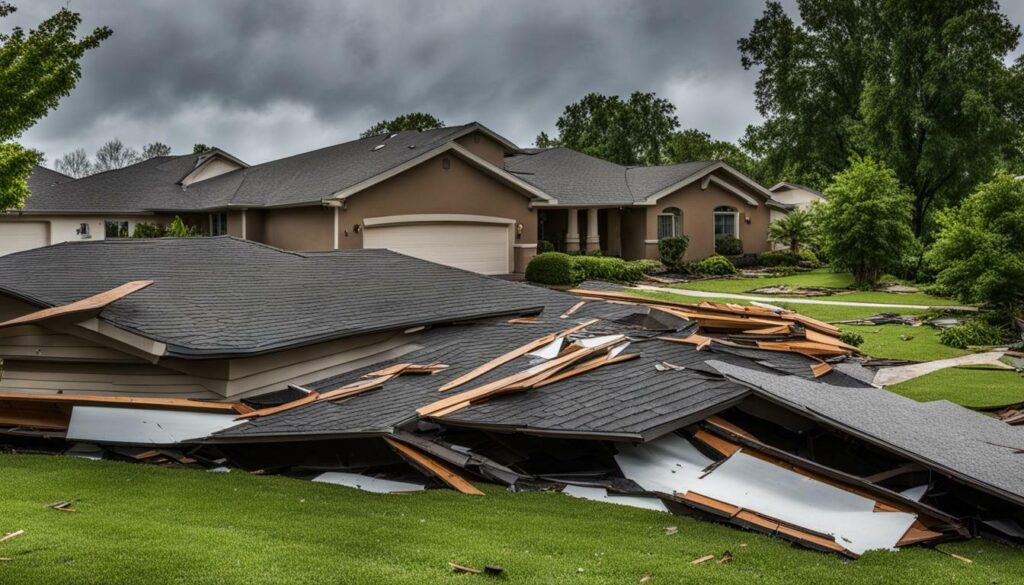
“If you notice any of these signs of roof damage, it’s crucial to address the issues promptly. Ignoring even minor damage can lead to major problems down the line, including structural damage and costly repairs.”
| Roof Damage | Assessment |
|---|---|
| Missing or damaged shingles | Inspect the entire roof surface for missing or damaged shingles. Look for any visible signs of shingle debris on the ground or in your gutters. |
| Cracked or curled shingles | Closely examine the shingles for cracks or curls. Run your hand over the surface to feel for any irregularities. |
| Leaks or water stains | Check your attic for any signs of water stains or leaks. Inspect the ceiling and walls in your home for any moisture or discoloration. |
| Granule loss | Inspect your gutters and downspouts for an excessive accumulation of granules. This could indicate deteriorating shingles. |
| Dented or dinged vents and flashing | Carefully examine roof vents and flashing for any signs of dents or dings caused by hail or flying debris. |
Preventative Measures for Roof Storm Damage
By implementing preventative measures, you can minimize the risk of roof damage caused by storms. Regular maintenance and choosing durable roofing materials are vital to protecting your home and avoiding costly repairs. Here are some key steps you can take to safeguard your roof.
- Inspect and repair: Conduct regular roof inspections to identify any existing damage or vulnerabilities. Look for signs of loose or missing shingles, cracked flashing, or damaged gutters. Addressing these issues promptly can prevent leaks and water damage during storms.
- Prevent leaks: Keep your gutters clean and free from debris to ensure proper drainage. Clogged gutters can lead to water buildup and potential roof damage. Consider installing gutter guards to minimize blockages and reduce the need for frequent cleaning.
- Avoid roof ponding: Roof ponding, or water accumulation on the roof’s surface, can lead to structural damage. Ensure your roof has proper drainage systems in place, such as downspouts and gutters, to prevent water from pooling.
- Protect against wind damage: High winds can cause significant roof damage. Secure loose shingles, tiles, or other roofing materials to minimize the risk of them being torn off during a storm. Consider installing wind-resistant roofing materials and reinforcing the edges of your roof.
- Minimize sun damage: Prolonged sun exposure can weaken roofing materials over time. Apply a reflective coating to your roof to minimize UV damage and extend its lifespan. Additionally, ensure your attic is properly insulated to reduce heat transfer and prevent excessive heat buildup in your home.
Remember, prevention is key when it comes to protecting your roof from storm damage. By following these preventative measures, you can minimize the risk of roof damage, prolong the lifespan of your roof, and ensure the safety and comfort of your home.
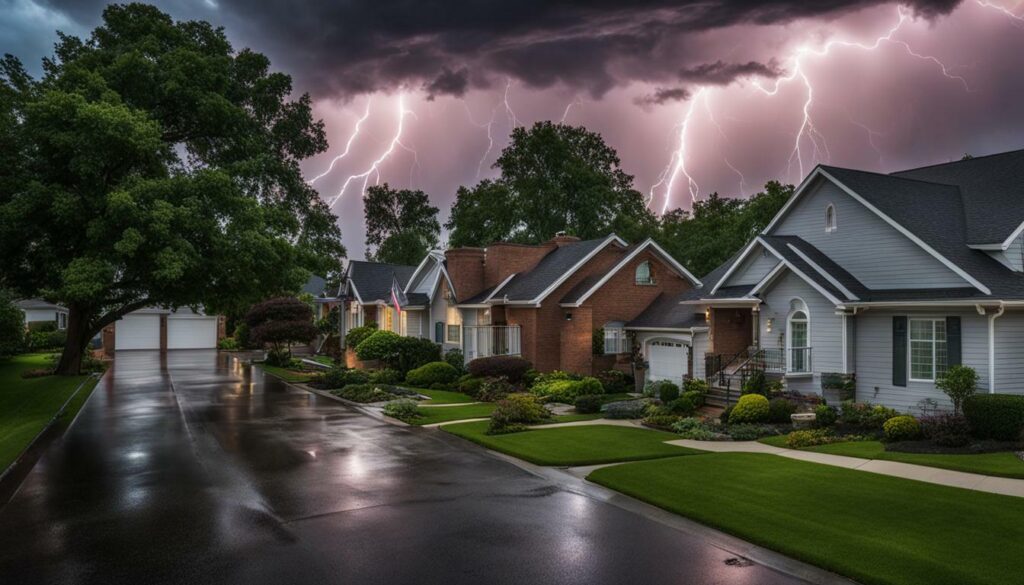
Roof Storm Damage Inspection
Regular roof inspections are crucial in assessing the condition of your roof and identifying potential storm damage. While you can visually inspect your roof from the ground, it’s best to hire a professional roofing contractor for a comprehensive assessment.
A qualified roofer will have the expertise to identify signs of damage that may not be visible to the untrained eye. They will inspect the entire roof system, including shingles, flashing, vents, and gutters. They can also assess the structural integrity and identify any areas that require immediate repair or reinforcement.
It’s recommended to schedule a roof inspection at least once a year, preferably in the spring or fall. However, it’s important to have your roof inspected after any major storm or severe weather event, as this can cause hidden damage that may worsen over time.
In conclusion, regular inspections and implementing preventative measures are essential to protect your home from roof damage caused by storms. By taking these proactive steps, you can ensure the longevity of your roof and minimize the risk of costly repairs.
Repairing Roof Damage from Storms
Restoring your roof after storm damage is crucial to maintaining the structural integrity of your home. Whether it’s missing shingles, leaks, or water damage, prompt repairs are essential to prevent further issues and costly repairs down the line.
A professional roofing contractor experienced in storm damage restoration can assess the extent of the damage and provide you with an effective repair plan. They have the knowledge and expertise to identify hidden issues and ensure that your roof is restored to its pre-storm condition.
When selecting a roofing contractor for storm damage repairs, it’s important to choose a reputable and licensed professional. Look for contractors who specialize in storm damage restoration and have positive customer reviews. This will give you confidence in their ability to handle your repair needs efficiently and effectively.
Additionally, your insurance company may require you to obtain multiple quotes from roofing contractors before approving your claim. Be sure to gather quotes from different contractors and compare their expertise, pricing, and warranties. This will help you make an informed decision and ensure that you receive the best quality of work.
| Benefits of Hiring a Roofing Contractor for Storm Damage Restoration |
|---|
| Expert assessment of roof damage |
| Efficient and timely repairs |
| Insurance claim assistance |
| Quality workmanship and materials |
| Warranty for repairs |
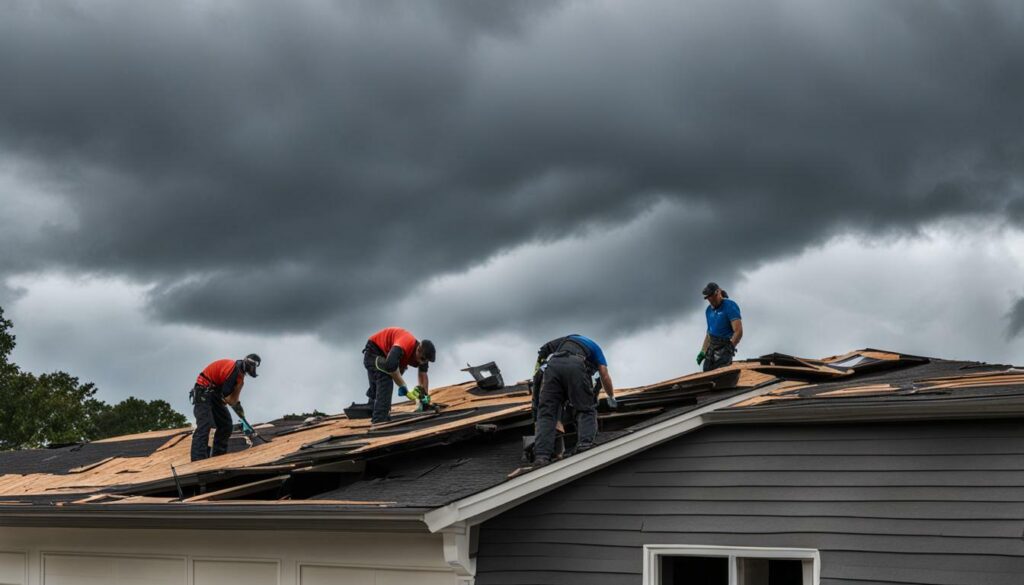
By prioritizing the repair of storm damage to your roof, you can ensure the safety and longevity of your home. Consult a professional roofing contractor experienced in storm damage restoration to address any issues promptly and effectively.
Roof Storm Damage Insurance Claim
If your roof has been damaged by a storm, filing an insurance claim can help cover the repair costs. It’s important to act promptly and follow the necessary steps to ensure a smooth and successful claim process. Documenting the damage with photographs and detailed descriptions will strengthen your case. Additionally, keeping records of any repairs or expenses incurred will support your claim.
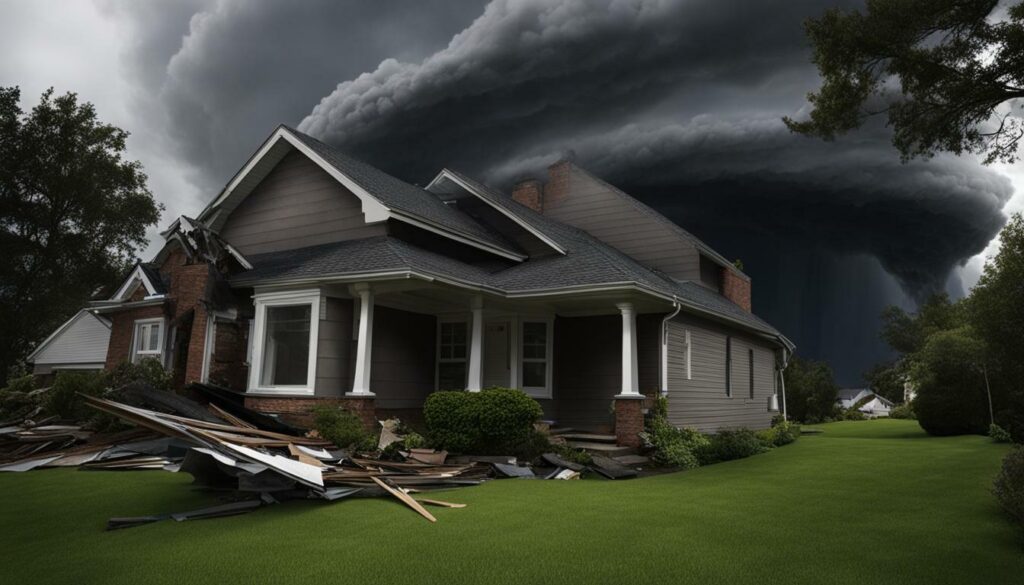
When filing an insurance claim for roof storm damage, it’s crucial to review your policy and understand your coverage. Consult with your insurance agent or company to clarify any questions or concerns you may have. They can guide you through the claim process and provide valuable information on the documentation required.
Working with a reputable roofing contractor who specializes in storm damage claims can be beneficial. They have experience in assessing roof damage and can provide detailed reports and estimates for the insurance company. Their expertise can help ensure that the extent of the damage is accurately documented, maximizing your claim coverage.
In conclusion, filing an insurance claim is a crucial step in recovering from roof storm damage. By documenting the damage, understanding your policy, and working with professionals, you can navigate the claims process effectively and receive the necessary funds for repair costs. Remember to act promptly and follow the necessary steps to ensure a successful outcome.
Preventing Specific Types of Roof Damage
Different types of storms can cause specific types of damage to your roof, requiring targeted preventative measures. By understanding these potential dangers, you can take proactive steps to protect your home and avoid costly repairs. Here are some key areas to focus on:
Addressing Roof Ponding
Roof ponding occurs when water collects and pools on your roof, usually due to poor drainage or inadequate slope. Over time, this can lead to water damage, leaks, and even structural issues. To prevent roof ponding, ensure that your gutters and downspouts are clear of debris and functioning properly. Regularly inspect and maintain your roof’s drainage systems to allow water to flow freely off the roof surface.
Preventing Wind Damage
High winds can cause significant damage to your roof, including lifting shingles, tearing off flashing, and even causing structural damage. To protect against wind damage, choose roofing materials that are specifically designed to withstand strong winds. Ensure that your roof is properly installed and secured, with nails or fasteners appropriately spaced and positioned. Regularly inspect your roof for any loose or damaged shingles and promptly repair or replace them.
Minimizing Sun Damage
Prolonged sun exposure can lead to deterioration of roofing materials, including cracking, fading, and warping. To minimize sun damage, consider installing materials that are designed to reflect sunlight and reduce heat absorption, such as cool roofs or light-colored roofing materials. Regularly inspect your roof for signs of sun damage, including blistering or curling shingles, and address any issues promptly to prevent further deterioration.
By implementing these preventative measures, you can protect your roof from the specific types of damage that storms may cause. Regular inspections, necessary repairs, and choosing durable roofing materials can go a long way in safeguarding your home and avoiding costly repairs in the future.
| Preventative Measures | Dangers |
|---|---|
| Address roof ponding | Water damage, leaks, structural issues |
| Prevent wind damage | Lifted shingles, torn flashing, structural damage |
| Minimize sun damage | Cracking, fading, warping of roofing materials |
“Regular inspections, necessary repairs, and choosing durable roofing materials can go a long way in safeguarding your home and avoiding costly repairs in the future.”

Implementing the appropriate preventative measures is essential to protect your roof from storm damage. By addressing roof ponding, preventing wind damage, and minimizing the impact of sun exposure, you can extend the lifespan of your roof and ensure the safety and integrity of your home.
Snow and Ice: Protecting Your Roof
Snow and ice can pose significant risks to your roof, but taking proactive steps can help minimize damage. By implementing the following preventative measures, you can safeguard your roof from the potential hazards of winter weather.
Using Roof Rakes
One effective method for protecting your roof from the weight of snow is to use a roof rake. These tools allow you to safely remove excess snow buildup without damaging the roof. Start from the edge and carefully work your way up the slope, being mindful not to scrape the surface of the shingles. Removing accumulated snow can help prevent structural strain and potential collapse.
Ensuring Proper Ventilation and Insulation
Proper ventilation and insulation are crucial for maintaining a healthy roof during winter. Adequate ventilation allows for the escape of warm air, preventing the formation of ice dams. Insulation helps keep your home warm, reducing the temperature difference between the interior and exterior of the roof and minimizing the risk of ice dams forming. Consult with a roofing professional to ensure your roof has sufficient ventilation and insulation.
Inspecting for Pests
During winter, pests such as rodents and birds may seek shelter in your attic or roof. They can cause damage by chewing through insulation, wiring, and even roof materials. Regularly inspect your attic and roof for signs of infestation, such as droppings or gnaw marks. If pests are detected, contact a pest control professional to address the issue promptly.
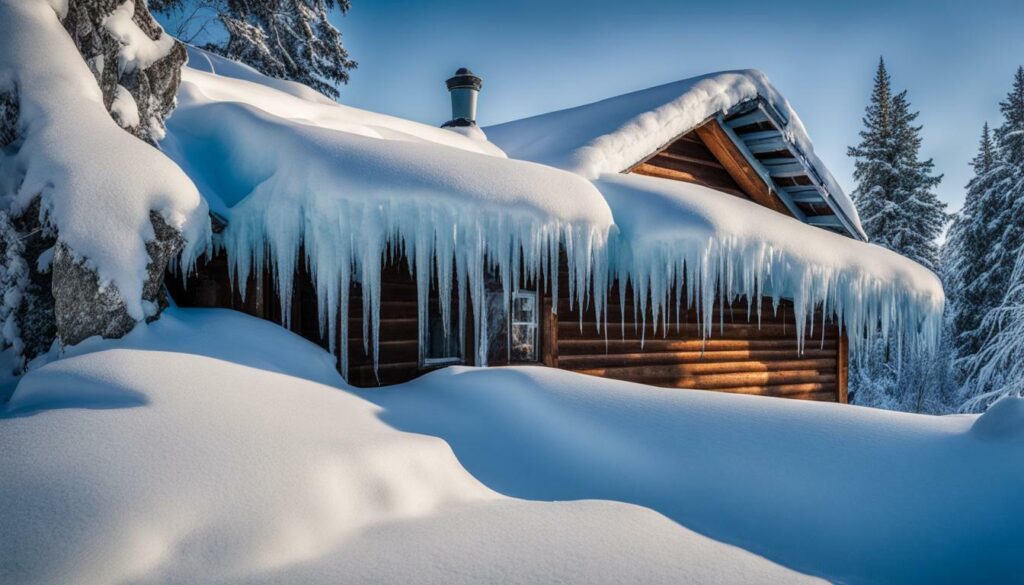
Taking these precautions will help protect your roof from the potential damage that snow and ice can cause. Remember to consult with a roofing professional for expert guidance and maintenance tips specific to your roof type and climate.
Preparing for Storms: Minimizing Roof Damage Risks
Being prepared before a storm hits can significantly reduce the chances of roof damage. By taking proactive measures, you can minimize the risks and protect your home from costly repairs. Here are some essential steps to consider:
- Cutting down trees: Trim or remove trees that are close to your home. During storms, strong winds can cause trees and branches to fall, resulting in severe damage to your roof. By cutting down trees near your property, you can prevent them from posing a threat during inclement weather.
- Cleaning gutters: Clearing your gutters of leaves, debris, and sediment is crucial to prevent clogging and water buildup. When gutters are blocked, rainwater cannot flow freely away from your roof, leading to leaks and potential water damage. Regular gutter cleaning will help maintain proper drainage and protect your roof.
- Securing outdoor objects: Before a storm arrives, secure any outdoor objects that could become projectiles in high winds. Patio furniture, potted plants, and other loose items should be safely stored or anchored to prevent them from causing additional damage to your roof or property.
By implementing these strategies, you can safeguard your home against roof damage caused by storms. Remember, prevention is key when it comes to protecting your roof and avoiding costly repairs. Stay proactive and stay safe!
| Key Steps to Minimize Roof Damage Risks |
|---|
| Cut down trees near your home |
| Clean gutters regularly |
| Secure outdoor objects |
Being prepared before a storm hits can significantly reduce the chances of roof damage.
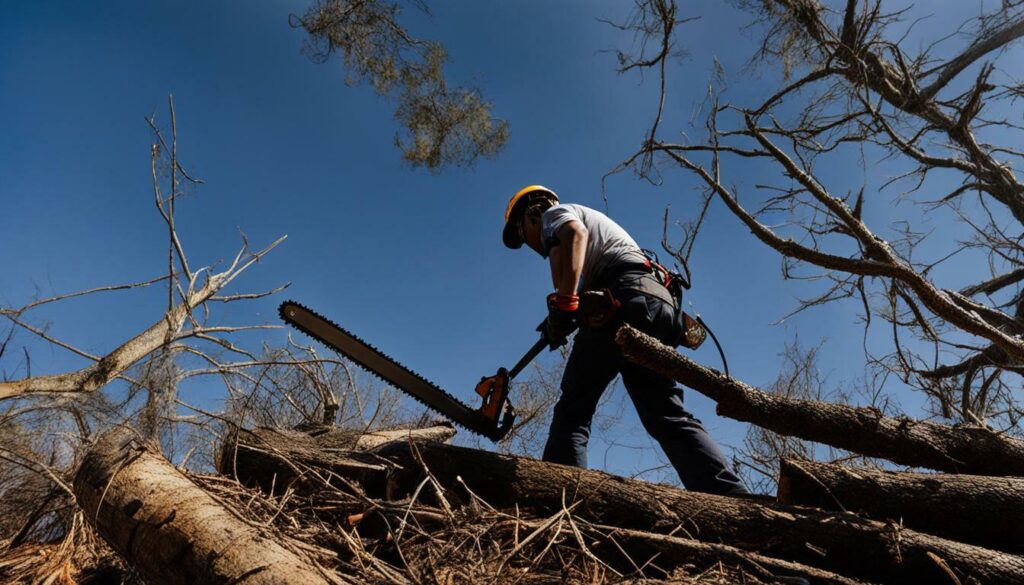
In Summary
To minimize roof damage risks during storms, it is essential to prepare your home in advance. This involves cutting down trees near your property, cleaning gutters regularly to ensure proper drainage, and securing outdoor objects to prevent them from becoming projectiles in high winds.
Durable Roofing Materials for Storm Resistance
Investing in a durable roofing material can provide long-term protection against storm damage. When it comes to safeguarding your home from the elements, choosing the right roofing material is essential. Here are some durable options that can withstand severe weather conditions:
| Roofing Material | Benefits |
|---|---|
| Asphalt Shingles | Cost-effective, widely available, and can resist strong winds and heavy rain. |
| Metal Roofing | Durable, fire-resistant, and can last up to 50 years. |
| Clay or Concrete Tiles | Highly durable, with excellent resistance to wind, fire, and extreme weather. |
| Slate Roofing | Natural stone with exceptional durability, longevity, and resistance to fire. |
| Wood Shingles | Classic and visually appealing, but require regular maintenance and treatment. |
Choosing the right roofing material depends on various factors, such as your budget, climate, and the style of your home. Consult with a professional roofing contractor to determine the best option for your specific needs.

Remember, having a durable roofing material is only part of the equation. Regular roof inspections and maintenance are crucial to ensure its continued effectiveness in protecting your home. Addressing any issues promptly can prevent small problems from escalating into extensive damage. Hiring a roofing contractor for regular inspections and repairs can provide peace of mind and help identify potential vulnerabilities before they become major problems.
Additionally, proper roof ventilation is important for maintaining the longevity of your roof. It helps prevent moisture buildup, which can lead to mold growth and deterioration of the roofing material. Securing outdoor objects, such as patio furniture and equipment, during storms can also minimize the risk of them becoming projectiles that can cause damage to your roof.
Key Takeaways:
- Investing in a durable roofing material can provide long-term protection against storm damage.
- Popular durable roofing materials include asphalt shingles, metal roofing, clay or concrete tiles, slate roofing, and wood shingles.
- Consult with a professional roofing contractor to determine the best roofing material for your specific needs.
- Regular roof inspections, maintenance, and proper ventilation are essential for preserving the integrity of your roof.
- Securing outdoor objects and practicing proactive storm preparedness measures can minimize the risk of roof damage.
Regular Roof Inspections and Maintenance
Regular inspections and maintenance are essential for identifying and addressing roof damage before it becomes severe. By conducting routine inspections, you can catch any potential issues early on and prevent them from escalating into more extensive and costly repairs. It is recommended to inspect your roof at least once a year, especially after severe weather events or storms.
During a roof inspection, carefully examine the entire surface for signs of damage, such as missing or damaged shingles, cracks, or leaks. Pay close attention to flashing around chimneys, vents, and skylights, as these are common areas where water can enter and cause problems. Additionally, check for any signs of roof ponding, where water accumulates and can lead to structural damage over time.
Regular maintenance goes hand in hand with inspections. This includes clearing out gutters and downspouts to ensure proper water drainage, as clogged gutters can cause water to backup and seep into the roof. Trim any overhanging tree branches that may pose a risk during storms, as they can break off and damage the roof. It is also important to remove any debris, such as leaves or branches, from the roof surface regularly.
| Regular Roof Inspections Checklist: | Regular Roof Maintenance Checklist: |
|---|---|
|
|
Regular roof inspections and maintenance should not be neglected, as they play a crucial role in protecting your home from costly roof damage caused by storms. If you are unsure about conducting an inspection yourself, it is recommended to hire a professional roofing contractor who can thoroughly assess your roof’s condition and provide necessary repairs or maintenance.
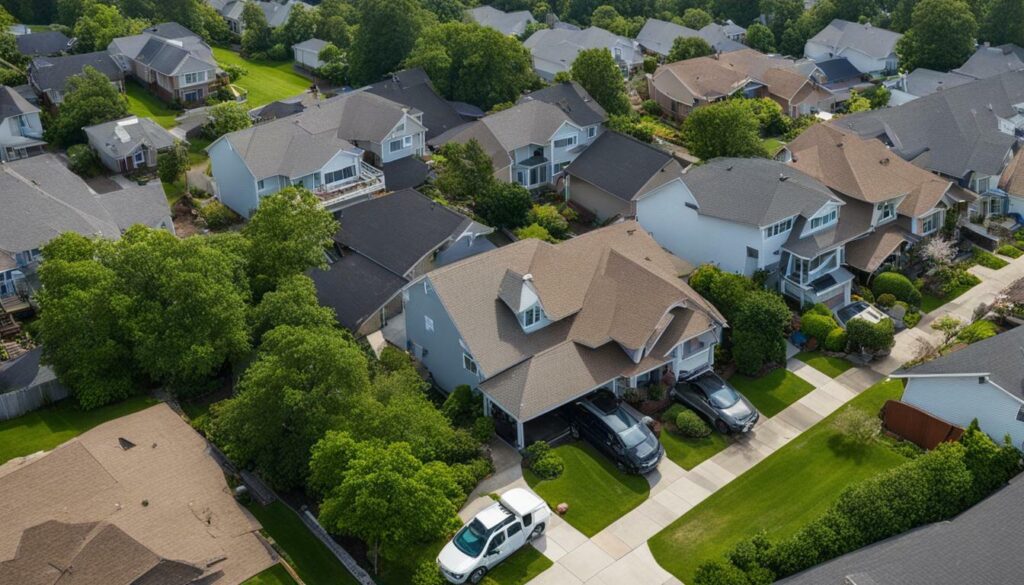
Benefits of Regular Roof Inspections and Maintenance:
“Regular inspections and maintenance help catch minor issues before they become major problems, saving you time, money, and stress in the long run.”
– John Doe, Roofing Expert
Protecting Your Home During Storms
Taking precautions to protect your home during storms can help safeguard your roof from unnecessary damage. By implementing these measures, you can minimize the risk of leaks, structural deterioration, and costly repairs. Here are some key steps to keep in mind:
- Park your cars in the garage: During storms with strong winds, debris can become airborne and cause significant damage to your vehicles. Parking them securely in the garage can help protect them from potential harm.
- Secure outdoor objects: Secure or store any outdoor furniture, equipment, or loose objects that can potentially become projectiles during high winds. These objects can cause severe damage to your roof and property if not properly secured.
- Ensure proper roof ventilation: Proper roof ventilation is crucial for preventing moisture buildup, which can lead to mold and rotting. It also helps regulate temperature and reduce stress on the roof during extreme weather conditions.
- Protect against strong winds and rain: Check for any loose or damaged shingles and replace them promptly. Make sure your gutters are clean and free of debris to prevent water from pooling and causing leaks. Regularly inspect your roof for any signs of damage and address them immediately.
Remember, regular roof inspections and repairs are essential to maintaining the integrity of your roof. Hiring a professional roofing contractor can ensure thorough inspections and necessary repairs are done in a timely manner. Additionally, removing outside debris and parking cars in the garage during storms can help prevent damage and provide peace of mind knowing that your home is protected.
Following these steps and investing in the durability of your roofing materials will go a long way in safeguarding your home and preventing potential roof damage caused by storms.

Storm Damage Prevention Checklist
To summarize, here’s a handy checklist to protect your home during storms:
| Preventive Measures | Actions |
|---|---|
| Park cars in the garage | Secure your vehicles indoors to avoid potential damage from flying debris. |
| Secure outdoor objects | Secure or store outdoor furniture, equipment, and loose objects that could become projectiles during high winds. |
| Ensure proper roof ventilation | Maintain proper roof ventilation to prevent moisture buildup and regulate temperature. |
| Protect against strong winds and rain | Regularly inspect and repair any loose or damaged shingles, clean gutters to prevent water pooling, and address signs of damage promptly. |
Conclusion
Protecting your home from roof damage caused by storms requires proactive measures and prompt action when damage occurs. Regular maintenance and choosing durable roofing materials are key to preventing costly repairs. Repairing missing shingles and maintaining gutters can effectively prevent leaks and water damage.
Addressing roof ponding, preventing wind damage, and protecting against sun damage are crucial in safeguarding your roof. Ensure that snow and ice don’t cause damage by using roof rakes, ensuring proper ventilation and insulation, and inspecting for pests. Taking the time to cut down trees and clean gutters before a storm can significantly minimize the risk of damage.
Installing a durable roofing material and hiring a reputable roofing contractor for inspections and repairs is essential. Proper roof ventilation and securing outdoor objects can protect against strong winds and rain. Regular roof inspections and repairs, along with removing outside debris and parking cars in the garage, can also prevent damage during storms.
By following these preventative measures and taking prompt action when damage occurs, you can protect your home from the devastating effects of roof damage caused by storms. Remember, investing in preventative measures today can save you from costly repairs in the future.
FAQ
Q: Why is protecting my home from roof damage caused by storms important?
A: Protecting your home from roof damage caused by storms is important to avoid costly repairs and potential structural damage. A well-maintained roof can withstand severe weather conditions and protect your home and belongings.
Q: How can I prevent roof damage from storms?
A: Regular maintenance and choosing durable roofing materials are effective ways to prevent roof damage from storms. Additionally, repairing missing shingles, maintaining gutters, and addressing roof ponding can help prevent leaks and water damage.
Q: What should I do if I notice signs of roof damage from storms?
A: If you notice signs of roof damage from storms, it’s important to assess the extent of the damage and take appropriate action. This may involve hiring a professional roofing contractor to inspect and repair the damage.
Q: How can I file an insurance claim for roof damage caused by storms?
A: To file an insurance claim for roof damage caused by storms, it’s important to document the damage, work with your insurance company, and provide necessary supporting documentation. Consulting with a public adjuster can also help maximize your claim coverage.
Q: What are some specific types of roof damage I should be aware of?
A: Some specific types of roof damage commonly caused by storms include roof ponding, wind damage, and sun damage. It’s important to address these issues proactively to prevent further damage.
Q: How can I protect my roof from snow and ice damage?
A: To protect your roof from snow and ice damage, you can use roof rakes to remove excess snow, ensure proper ventilation and insulation to prevent ice dams, and inspect for pests that may seek shelter on your roof during winter storms.
Q: What can I do to minimize roof damage risks before a storm?
A: Before a storm, you can minimize roof damage risks by cutting down trees near your home, cleaning gutters to prevent water backups, and securing outdoor objects that can become projectiles during high winds.
Q: What are some durable roofing materials that can resist storm damage?
A: Some durable roofing materials that can resist storm damage include asphalt shingles, metal roofing, and clay or concrete tiles. These materials are designed to withstand severe weather conditions.
Q: How often should I have my roof inspected and maintained?
A: It’s recommended to have your roof inspected and maintained at least once a year, preferably before the stormy season. Regular inspections and maintenance can help identify and address potential issues before they become major problems.
Q: How can I protect my home during storms to minimize roof damage?
A: To protect your home during storms, you can park cars in the garage, secure outdoor objects, and ensure proper roof ventilation to withstand strong winds and heavy rain.
